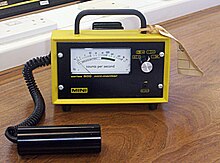 A "two-piece" bench-type Geiger–Müller counter using a cylindrical end-window detector connected to an electronics module with analogue readout | |
| Other names | Geiger Counter |
|---|---|
| Inventor | Hans Geiger, Walther Müller |
| Related items | Geiger–Müller tube |
A Geiger counter (/ˈɡaɪɡər/, GY-gər;[1] also known as a Geiger–Müller counter or G-M counter) is an electronic instrument used for detecting and measuring ionizing radiation. It is widely used in applications such as radiation dosimetry, radiological protection, experimental physics and the nuclear industry.
It detects ionizing radiation such as alpha particles, beta particles, and gamma rays using the ionization effect produced in a Geiger–Müller tube, which gives its name to the instrument.[2] In wide and prominent use as a hand-held radiation survey instrument, it is perhaps one of the world's best-known radiation detection instruments.
The original detection principle was realized in 1908 at the University of Manchester,[3] but it was not until the development of the Geiger–Müller tube in 1928 that the Geiger counter could be produced as a practical instrument. Since then, it has been very popular due to its robust sensing element and relatively low cost. However, there are limitations in measuring high radiation rates and the energy of incident radiation.[4]
The Geiger counter is one of the first examples of data sonification.[5]
- ^ "Geiger counter | Pronunciation in English".
- ^ Cite error: The named reference
centwas invoked but never defined (see the help page). - ^ E. Rutherford and H. Geiger (1908) "An electrical method of counting the number of α particles from radioactive substances," Proceedings of the Royal Society (London), Series A, vol. 81, no. 546, pages 141–161.
- ^ Cite error: The named reference
knollwas invoked but never defined (see the help page). - ^ "What is Sonification - Accessible Oceans". What is data sonificaiton. Woods Hole Oceanographic Institute. Retrieved 2024-05-30.